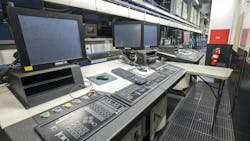New report sees surge in OT cybersecurity awareness among manufacturers
What you’ll learn:
- The Rockwell report notes six “forces” that are pushing the OT cybersecurity boulder uphill from afterthought to a backbone business necessity.
- Nearly every manufacturer surveyed is adopting an OT security platform, with 64% already running one and 32% planning to deploy one within five years.
- The report notes 53% of respondents listed securing OT assets as a primary spark for technology investment.
The topline theme from the newest State of Smart Manufacturing Report by Rockwell Automation: Urgency for better cybersecurity—especially in often-older plant operational technology—is finally beginning to sink in, as almost all of the 1,560 surveyed decision-makers said bolstering their plants’ cyber defenses ranks equally as important as traditional performance metrics such as safety, throughput of the products they make, and cost controls.
See also: Securing smart factories when the ‘attack surface’ keeps expanding
The 10th such report by Rockwell Automation that surveyed executives and other decision-makers in 17 leading manufacturing nations conducted in association with Sapio Research, the companies represented $100 million to multibillion-dollar production operations. And 96% of them said they have already invested or plan to invest in cybersecurity platforms within the next five years, and more than half are already adopting cybersecurity at-scale.
“Executives who once treated security as a ‘compliance tax’ now ask how many audit hours disappear, how much downtime is avoided, and how quickly AI‑ready data streams open up once networks are hardened. In short: Resilience has become a profit lever,” the Rockwell report states.
The Rockwell Automation survey drew respondents from a range of industries such as consumer packaged goods, food and beverage, automotive, semiconductor, energy and life sciences.
Upcoming webinar: Cybersecurity challenges, courtesy of AI
The report also notes six “forces” (and cites data points to back them up) that are pushing the OT cybersecurity boulder uphill from afterthought to a backbone business necessity: universal platform adoption; budget synergies with automation; board of directors‑level risk scrutiny; secure‑by‑design hardware; a workforce that has become literate of cyber risks and responsibilities; and a culture where safety and cybersecurity co-exist.
Near‑unanimous adoption of OT cybersecurity platforms
The Rockwell Automation survey found nearly every manufacturer is adopting an OT security platform, with 64% already running one and 32% planning to deploy within five years. That leaves a scant 4% who said their companies have no such aspiration or need to improve OT cybersecurity.
“Executives now quiz vendors on how many audit hours can be saved, how quickly patches can be deployed, and how much unplanned downtime can be decreased. Teams that link risk dashboards to metrics that operations and finance already track—think OEE or mean time to recovery—hold the upper hand.”
OT cybersecurity becomes ‘spark’ for technology investment
The report also noted 53% of respondents listed securing OT assets as a primary spark for technology investment, meaning more than half are already adopting security at-scale.
“This digital transformation shift recasts security leaders as growth enablers,” according to the blog about the report, which adds that stakeholders are positioned to make “hardened networks as the foundation for predictive maintenance, real‑time energy management or AI‑assisted quality checks, and risk reduction suddenly comes with revenue upside. Looming deadlines, like NIS2 in Europe or CISA’s directives in the U.S., only sharpen executive focus.”
Cybersecurity ranks as a top external threat to manufacturing
A third of respondents ranked cyber risk among their most serious external obstacles. Executives and the insurers that underwrite their risk, according to the report, now expect precise metrics: projected financial loss if a cyber incident hits, how often response drills are run and what they uncover, and a clear, scored view of control maturity across the OT environment.
Secure‑by‑design hardware steps to the fore
The Rockwell report gets a little bit into the weeds about specific technologies that form the basis of OT cybersecurity measures, and one of them is embedded security controls. The new report cites 31% of respondents aim to curb risk of attack on their OT with these security controls.
See also: Who do you trust? In manufacturing, the answer should be no one
“Controller-level access rules, signed firmware, and onboard telemetry are becoming standard features,” the company added. “These deeper defenses, however, demand disciplined firmware-lifecycle management and procurement language that prioritizes security alongside performance specifications.”
Workforce cyber skills move to baseline
A top report insight saw 81% of respondents to Rockwell place a high or top-tier priority on knowledge among staff about cyber practices and standards. Nearly half of respondents (47%) ranked these skills as “extremely important” when hiring over the next 12 months, with another 34% calling them “very important.”
“Manufacturers are embedding micro-training into shift handovers, funding certifications, and tying security performance (e.g., patch compliance) to individual reviews,” according to the blog with the report. “Over time, secure behavior becomes as routine as lockout/tagout procedures.”
Culture can be the final hurdle to adoption
Another survey insight points to pain points related to company culture necessary for cybersecurity: A quarter of respondents said resistance to change among their employees blocks “smart” manufacturing rollouts, and another 25% flagged limited cybersecurity awareness among senior decision-makers as a top leadership obstacle over the next year.
See also: Survey shows ‘widespread governance failures’ in AI data security
“Mindset, not knowledge, often slows progress,” the Rockwell blog adds. “Operators may see additional controls as production bottlenecks, while managers prioritize short-term output. Embedding cybersecurity in the broader safety culture, supported by recognition programs and cross-functional drills, turns secure behavior into shared muscle memory.”
About the Author
Scott Achelpohl
Head of Content
I've come to Smart Industry after stints in business-to-business journalism covering U.S. trucking and transportation for FleetOwner, a sister website and magazine of SI’s at Endeavor Business Media, and branches of the U.S. military for Navy League of the United States. I'm a graduate of the University of Kansas and the William Allen White School of Journalism with many years of media experience inside and outside B2B journalism. I'm a wordsmith by nature, and I edit Smart Industry and report and write all kinds of news and interactive media on the digital transformation of manufacturing.

